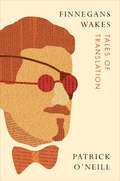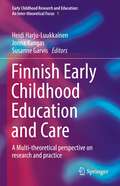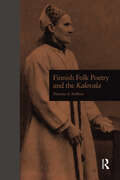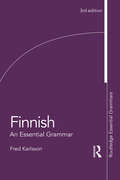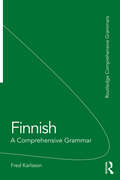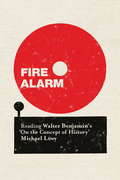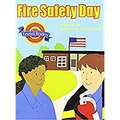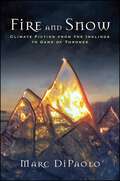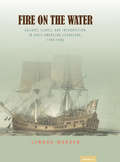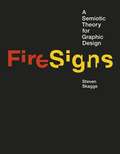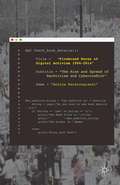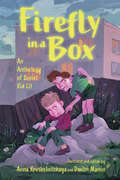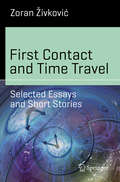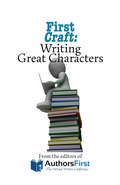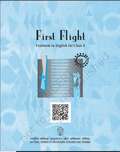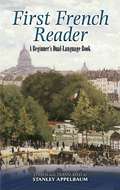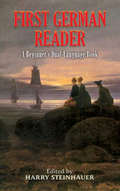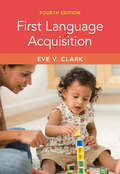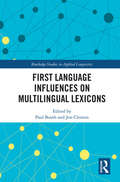- Table View
- List View
Finnegans Wakes: Tales of Translation
by Patrick O'NeillJames Joyce's astonishing final text, Finnegans Wake (1939), is universally acknowledged to be entirely untranslatable. And yet, no fewer than fifteen complete renderings of the 628-page text exist to date, in twelve different languages altogether – and at least ten further complete renderings have been announced as underway for publication in the early 2020s, in nine different languages. Finnegans Wakes delineates, for the first time in any language, the international history of these renderings and discusses the multiple issues faced by translators. The book also comments on partial and fragmentary renderings from some thirty languages altogether, including such perhaps unexpected languages as Galician, Guarani, Chinese, Korean, Turkish, and Irish, not to mention Latin and Ancient Egyptian. Excerpts from individual renderings are analysed in detail, together with brief biographical notes on numerous individual translators. Chronicling renderings spanning multiple decades, Finnegans Wakes illustrates the capacity of Joyce's final text to generate an inexhaustible multiplicity of possible meanings among the ever-increasing number of its impossible translations.
Finnish Early Childhood Education and Care: A Multi-theoretical perspective on research and practice (Early Childhood Research and Education: An Inter-theoretical Focus #1)
by Susanne Garvis Heidi Harju-Luukkainen Jonna KangasThis book highlights contemporary questions around Early Childhood Education in Finland. It explores a range of issues relating to policies and practices in Early Childhood Education and Care (ECEC). The book features many aspects of the so-called Nordic model that is evident in different practices and policies of the Finnish ECEC system. Among others topics, it discusses playful learning, storycrafting, scientific literacy, pedagogical leadership, family-related variables, and Sami language learning. The findings provide important insights into the Finnish ECEC model and illustrate relevant issues facing Finland. All of the 14 chapters present unique research and give the reader the opportunity to understand how the ECEC services during children’s early years are defined and implemented. Each chapter includes a discussion of the educational outcome and highlights critical perspectives. In Finland ECEC is seen as an investment in the future. The Finnish ECEC system is one of the most equal in the world. The high-quality education is available to both private and public sectors. National curriculum and laws for early education have gone through a significant reform during the last decade, with the quality, practices and teachers’ competences being defined in order to support children’s future learning skills. ECEC in Finland is a unique combination of international influences and local intentions to put each child and family at the centre of the services. The systematic and goal-oriented ECEC system consists of upbringing, education and care with an emphasis on pedagogy in order to produce excellence for the future. Its overall planning, guidance and monitoring system is one of a kind.
Finnish Folk Poetry and the Kalevala (New Perspectives in Folklore #1)
by Thomas A. DuBoisSince its initial publication in the early nineteenth century, Elias Lonnrot’s Finnish epic Kalevala has attracted international interest and scholarship. However, the author comments that the distorting lenses of translation, cultural difference and historical distance, have rendered the work a cryptic and often misinterpreted text outside of its country of origin. Even within Finland, scholars have found it difficult at times to judge the relation of the Kalevala to its oral sources. Lonnrot’s meticulous notes and discussions of intent and accomplishment make clear what he changed and how he went about it, but give us less inkling of why. This study's view is that the key to understanding Lonnrot’s changes lies in Romantic aesthetics and in the intellectual and socio-political agendas which they encode. Lonnrot created a Romantic epic out of Baltic-Finnic folk poetry, an epic complete with the narrative, generic, gendered and political characteristics of literary epics in nineteenth century’ Europe.
Finnish: A Comprehensive Grammar (Routledge Essential Grammars)
by Fred KarlssonThis thoroughly revised third edition of Finnish: An Essential Grammar is grounded in fundamental insights of modern linguistics and incorporates some of the latest achievements in the description of written and spoken Finnish. It gives a systematic account of the structures of the written language and offers increased attention to the key characteristics of present-day colloquial Finnish. No prior knowledge is assumed on the part of the reader and grammatical rules are clearly explained without jargon. Features of this new edition include: • pronunciation guide, including the tendencies in present-day colloquial Finnish • thorough descriptions of morphology (word structure) and syntax (sentence structure) • clear rules and an abundance of concrete examples, from both written and colloquial Finnish • updated vocabulary in the examples • an effective new scheme for detecting the morphological structure of any word form • subject index. This is the ideal reference source both for those studying Finnish independently and for students in schools, colleges, universities and adult classes of all types.
Finnish: A Comprehensive Grammar (Routledge Grammars)
by Fred KarlssonFinnish: A Comprehensive Grammar presents a fresh, accessible and thorough description of the language, concentrating on the real patterns of use in modern Finnish. The book moves from the sound system through morphology and word classes to a detailed analysis of sentence structures and semantic features. Key features include: particular focus on examples from spoken Finnish reflecting current usage, grammatic phenomena classified as common or rare, appendices distinguishing base forms from final letter combinations, English-Finnish contrasts highlighted throughout. This Comprehensive Grammar is an essential reference for the intermediatre and advanced learner and user of Finnish.
Fins, Wings, and Legs
by Rachel Griffiths Margaret ClyneComplete Classroom Library includes one each of the following: Math LibraryScience LibrarySocial Studies LibraryContent Area Classroom Libraries include: 1 display box containing 10 6-packs (60 little books)1 Teacher Resource Portfolio1 Assessment Book (where available)Big Book Collection includes: 10 Big Books for Science10 Big Books for Social Studies10 Big Books for MathClassroom Library Add-on Packs include 1 copy of each title from the social studies, science, and math libraries. Add-On Packs include 1 copy of each title.
Fire Alarm: Reading Walter Benjamin's 'On the Concept of History'
by Chris Turner Michael LowyThis illuminating study of Benjamin's final essay helps unlock the mystery of this great philosopherRevolutionary critic of the philosophy of progress, nostalgic of the past yet dreaming of the future, romantic partisan of materialism -- Walter Benjamin is in every sense of the word an "unclassifiable" philosopher. His essay "On the Concept of History" was written in a state of urgency, as he attempted to escape the Gestapo in 1940, before finally committing suicide.In this scrupulous, clear and fascinating examination of this essay, Michael Löwy argues that it remains one of the most important philosophical and political writings of the twentieth century. Looking in detail at Benjamin's celebrated but often mysterious text, and restoring the philosophical, theological and political context, Löwy highlights the complex relationship between redemption and revolution in Benjamin's philosophy of history.From the Trade Paperback edition.
Fire Up Your Writing Brain: How to Use Proven Neuroscience to Become a More Creative, Productive, and Succes sful Writer
by Susan ReynoldsIgnite Your Writing Brain!Whether you're an experienced writer or just starting out, an endless number of pitfalls can trip up your efforts, from procrastination and writer's block to thin characters and uninspired plots. Luckily, you have access to an extraordinary writing tool that can help overcome all of these problems: your brain.Fire Up Your Writing Brain teaches you how to develop your brain to its fullest potential. Based on proven, easy-to-understand neuroscience, this book details ways to stimulate, nurture, and hone your brain into the ultimate writing tool. Inside, you'll learn how to:Identify the type of writer you are: Do you think or feel your way through writing a book? Are you a pantser or a plotter?Develop writing models that accelerate your learning curve.Hardwire your brain for endurance and increased productivity.Brainstorm better character concepts and plot points.Learn to edit your manuscript on both a macro and micro level.Recharge a lagging brain to gain an extra burst of creativity.Filled with accessible instruction, practical techniques, and thought-provoking exercises, Fire Up Your Writing Brain shows you how to become a more productive, creative, and successful writer--a veritable writing genius!"An excellent resource--the way that neuroscience and the art of writing are jointly explored allows for a new, unique, and practical integration of the two." --Teresa Aubele-Futch, Ph.D., Assistant Professor of Neuroscience at Saint Mary's College, Notre Dame and co-author of Train Your Brain to Get Happy and Train Your Brain to Get Rich"Full of neuroscience facts and tips, this inspiring book will change your brain--and your writing life. I learned techniques that I'll apply to my students and my own writing." --Linda Joy Myers, President of the National Association of Memoir Writers and award-winning author of Don't Call Me Mother: A Daughter's Journey from Abandonment to Forgiveness
Fire and Snow: Climate Fiction from the Inklings to Game of Thrones (SUNY Press Open Access)
by Marc DiPaoloFellow Inklings J. R. R. Tolkien and C. S. Lewis may have belonged to different branches of Christianity, but they both made use of a faith-based environmentalist ethic to counter the mid-twentieth-century's triple threats of fascism, utilitarianism, and industrial capitalism. In Fire and Snow, Marc DiPaolo explores how the apocalyptic fantasy tropes and Christian environmental ethics of the Middle-earth and Narnia sagas have been adapted by a variety of recent writers and filmmakers of "climate fiction," a growing literary and cinematic genre that grapples with the real-world concerns of climate change, endless wars, and fascism, as well as the role religion plays in easing or escalating these apocalyptic-level crises. Among the many other well-known climate fiction narratives examined in these pages are Game of Thrones, The Hunger Games, The Handmaid's Tale, Mad Max, and Doctor Who. Although the authors of these works stake out ideological territory that differs from Tolkien's and Lewis's, DiPaolo argues that they nevertheless mirror their predecessors' ecological concerns. The Christians, Jews, atheists, and agnostics who penned these works agree that we all need to put aside our cultural differences and transcend our personal, socioeconomic circumstances to work together to save the environment. Taken together, these works of climate fiction model various ways in which a deep ecological solidarity might be achieved across a broad ideological and cultural spectrum.This book is freely available in an open access edition thanks to Knowledge Unlatched—an initiative that provides libraries and institutions with a centralized platform to support OA collections and from leading publishing houses and OA initiatives. Learn more at the Knowledge Unlatched website at: https://www.knowledgeunlatched.org/, and access the book online at the SUNY Open Access Repository at <a href="http://hdl.handle.net/20.500.12648/7137 ">http://hdl.handle.net/20.500.12648/7137 .
Fire on the Water: Sailors, Slaves, and Insurrection in Early American Literature, 1789-1886 (Transits: Literature, Thought & Culture 1650-1850)
by Lenora WarrenLenora Warren tells a new story about the troubled history of abolition and slave violence by examining representations of shipboard mutiny and insurrection in late eighteenth- and early nineteenth-century Anglo-American and American literature. Fire on the Water centers on five black sailors, whose experiences of slavery and insurrection either inspired or found resonance within fiction: Olaudah Equiano, Denmark Vesey, Joseph Cinqué, Madison Washington, and Washington Goode. These stories of sailors, both real and fictional, reveal how the history of mutiny and insurrection is both shaped by, and resistant to, the prevailing abolitionist rhetoric surrounding the efficacy of armed rebellion as a response to slavery. Pairing well-known texts with lesser-known figures (Billy Budd and Washington Goode) and well-known figures with lesser-known texts (Denmark Vesey and the work of John Howison), this book reveals the richness of literary engagement with the politics of slave violence. Published by Bucknell University Press. Distributed worldwide by Rutgers University Press.
FireSigns: A Semiotic Theory for Graphic Design
by Steven SkaggsGraphic design has been an academic discipline since the post-World War II era, but it has yet to develop a coherent theoretical foundation. Instead, it proceeds through styles, genres, and imitation, drawing on sources that range from the Bauhaus to deconstructionism. In FireSigns, Steven Skaggs offers the foundation for a semiotic theory of graphic design, exploring semiotic concepts from design and studio art perspectives and offering useful conceptual tools for practicing designers.Semiotics is the study of signs and significations; graphic design creates visual signs meant to create a certain effect in the mind (a "FireSign"). Skaggs provides a network of explicit concepts and terminology for a practice that has made implicit use of semiotics without knowing it. He offers an overview of the metaphysics of visual perception and the notion of visual entities, and, drawing on the pragmatic semiotics of the philosopher Charles Sanders Peirce, looks at visual experience as a product of the action of signs. He introduces three conceptual tools for analyzing works of graphic design -- semantic profiles, the functional matrix, and the visual gamut -- that allow visual "personality types" to emerge and enable a greater understanding of the range of possibilities for visual elements. Finally, he applies these tools to specific analyses of typography.
Firebrand Waves of Digital Activism 1994-2014: The Rise and Spread of Hacktivism and Cyberconflict
by Athina KaratzogianniThis book introduces four waves of upsurge in digital activism and cyberconflict. The rise of digital activism started in 1994, was transformed by the events of 9/11, culminated in 2011 with the Arab Spring uprisings, and entered a transformative phase of control and mainstreaming since 2013 with the Snowden affair.
Firefly in a Box: An Anthology of Soviet Kid Lit (Cultures of Childhood)
by Anna Krushelnitskaya Dmitri ManinContributions by Marina Balina, Sibelan Forrester, Anna Krushelnitskaya, Dmitri Manin, Svetlana Maslinskaya, Ainsley Morse, and Serguei Alex. OushakineIn Firefly in a Box: An Anthology of Soviet Kid Lit, translators Anna Krushelnitskaya and Dmitri Manin present a hybrid scholarly and literary volume of popular Russian-language Soviet children’s texts alongside essays that outline the significance and meanings behind these popular texts. The selection features both poetry and short prose, all of which are instantly recognizable to a Soviet native, and all of which hold cultural currency, potency, and valence similar to popular children’s literature in the United States, such as Green Eggs and Ham, Curious George, or Make Way for Ducklings. These texts have either never been translated into English before or appear in all-new translations, literary rather than literal; the featured original Soviet illustrations are reprinted for the English-reading market for the first time. Alongside the translations themselves is a scholarly component that guides Anglophone readers to experience mainstays of Soviet children’s writing. Essayists investigate literary material and perspectives using a broad range of approaches and methodologies applied to Soviet children’s literature. Topics include the Soviet literary canon, the beginning and evolution of Soviet children’s literature in the 1920s and 1930s, interactions between literary texts for children and folklore, and the interplay between Soviet and British children’s poetry.
First Buddhist Women
by Susan MurcottFirst Buddhist Women is a readable, contemporary translation of and commentary on the enlightenment verses of the first female disciples of the Buddha. Through the study of the Therigatha, the earliest-known collection of women's religious poetry, the book explores Buddhism's 2,600-year-long liberal attitude toward women. Utilizing commentary and storytelling, author Susan Murcott traces the journey of wives, mothers, teachers, courtesans, prostitutes, and wanderers who became leaders in the Buddhist community, acquiring roles that even today are rarely filled by women in other, patriarchal religions.
First Contact and Time Travel: Selected Essays and Short Stories (Science and Fiction)
by Zoran ŽivkovićThis volume collects both essays and fictional material around two core topics in the long career of the Serbian writer, essayist, researcher, publisher and translator. The first topic - first contact - is chiefly represented by his comprehensive essay on "The Theme of First Contact in the SF Works of Arthur C. Clarke" and reflected on the literary level with his short stories "The Bookshop" and "The Puzzle". Two shorter essays on the second topic - time travel in SF literature - introduce, amongst others, the well-known and fascinating mosaic novel Time Gifts, which skillfully explores the more literary side of the notions of past, present and future. In the annotations the author provides insights into his take on the subjects presented.
First Craft: Writing Great Characters
by Editors of Authors FirstAn invaluable guide for fiction writers who want to learn how to create unforgettable characters. Readers love fiction first and foremost because they get to LIVE in the stories they read. The story's characters are the conduit to that experience, and storytellers that create memorable, relatable characters connect with readers at the most fundamental level. All fiction writers need to master the skills involved in creating great characters if they're going to connect with a meaningful audience. The challenge, of course, is that creating great characters is anything but easy. So how do you do it? Let the contributors to this book - all established novelists - show you the way. From essentials like knowing your characters and giving them personality to more nuanced concepts like shading characters and even using places as characters, FIRST CRAFT: WRITING GREAT CHARACTERS is a brief text packed with advice gleaned from decades of writing experience. Each chapter includes illustrations from the author's own work along with useful exercises that will help your characters walk right off the page. FIRST CRAFT: WRITING GREAT CHARACTERS is presented by AuthorsFirst, the virtual writers conference that has dozens and dozens of craft sessions available online and that sponsors an annual fiction writing contest. Contributors to this volume include New York Times bestselling author Lou Aronica, national bestselling authors Mary Marcus, John L. Hart, and Emily Sue Harvey, acclaimed novelists Leora Skolkin-Smith and K.J. Steele, and praised memoirist Marcia Gloster.
First Exposure to a Second Language
by Zhaohong Han Rebekah RastThe initial state of learner spontaneous input processing in foreign language learning, as well as the extent to which this processing leads to intake, is of central importance to theoreticians and teachers alike. In this collection of original studies, leading experts examine a range of issues, such as what learners do when faced with a language they know little or nothing about, what factors appear to mediate beginning learners' processing of input, how beginners treat two types of information - form and meaning - in the input, and how adult cognition deals with stimulus frequency at this initial stage. This book provides a microscopic view on learners' processing of foreign language input at the early stages of learning, and evaluates a variety of methodological options within the context of ab initio processing of foreign languages other than English, such as German, Korean, Norwegian, Polish, and Spanish.
First Flight class 10 - JCERT
by Jharkhand Council of Educational Research and Training RanchiThe book "First Flight" is a textbook in English for Class X, aimed at developing students' language and literary skills. It includes a variety of genres like fiction, diary entries, and travelogues, which introduce students to diverse themes, such as individual and societal relationships, emotions, and historical figures like Nelson Mandela and Anne Frank. The stories emphasize moral lessons, critical thinking, and communication skills, while the accompanying poems and exercises encourage reflection on personal experiences.
First Flight class 10 - NCERT - 23 (English Textbook)
by National Council of Educational Research and Training"First Flight" is a textbook designed for Class X students by NCERT. It is an amalgamation of various literary pieces, from poems to short stories, aimed at enhancing the English proficiency of students. The content is thoughtfully curated to introduce students to diverse cultures, ideologies, and thought processes, while also providing moral and ethical lessons. Themes of resilience, courage, love, sacrifice, and the quintessential spirit of human nature are interwoven throughout the text. The book not only aids in developing linguistic abilities but also encourages students to reflect upon life's essential values and virtues. Regular exercises and questions at the end of each chapter ensure comprehension and retention, paving the way for a robust foundation in the English language.
First French Reader: A Beginner's Dual-Language Book
by Stanley AppelbaumThis excellent anthology offers the beginning French-language student a first taste of some of the world's most significant prose. Chosen for both their eloquence and ease of reading, excerpts from such masterpieces as Les Misérables, The Red and the Black, Madame Bovary, Carmen, and The Three Musketeers will open new worlds for linguists. Readers will savor the words of fifty great writers of multiple genres from the seventeenth through twentieth centuries, including Voltaire, Rousseau, Balzac, Baudelaire, Dumas, Proust, and other literary virtuosos.Lucid and accessible, the unabridged English translations by Stanley Appelbaum appear on pages that face the original French text. Literature lovers, French-language students, and other readers will find this volume a fascinating exploration of French literature...and an invaluable aid to mastering one of the world's most romantic languages.
First German Reader: A Beginner's Dual-Language Book
by Harry SteinhauerDesigned expressly for the beginning German language student, here is an outstanding collection of fifty-two short stories, poems, essays, and anecdotes. Each selection has been specially chosen for its power to evoke German life and culture. This dual-language edition features precise English translations on pages that face the original German text. New students will enjoy the pleasure of reading great German literature from the very first page, as the selections have been arranged to accommodate the gradual improvement of language skills. Helpful vocabulary and language exercises are also included. First German Reader features the works of many of Germany's best writers, including Goethe, Hesse, Heine, Schiller, Hölderlin, and other literary virtuosos. The translations of Harry Steinhauer are vivid and true to the originals--and poetic in their own right. Literature lovers, German language students, and other readers will find this volume an accessible exploration of German literature . . . and an invaluable aid to mastering the German language.
First Language Acquisition
by Clark Eve V.How do young children learn language? When does this process start? What does language acquisition involve? Children are exposed to language from birth, surrounded by knowledgeable speakers who offer feedback and provide extensive practice every day. Through conversation and joint activities, children master the language being used around them. This fully revised third edition of Eve V. Clark's bestselling textbook offers comprehensive coverage of language acquisition, from a baby's first sounds to a child's increasing skill in negotiating, explaining and entertaining with language. This book, drawing together the most recent findings in the field, and illustrated with examples from a wide range of experimental and observational studies, including the author's own diary observations, presents an essential and comprehensive guide to first language acquisition. It will be fascinating reading for students of linguistics, developmental psychology, and cognitive science.
First Language Acquisition
by Eve V. ClarkNow in its fourth edition, this textbook provides a chronological account of first language acquisition, showing how young children acquire language in their conversational interactions with adult speakers. It draws on diary records and experimental studies from leaders in the field to document different stages and different aspects of what children master. Successive chapters detail infants' and young children's progression from attending to adult faces, gaze, and hand motions, to their first attempts at communicating with gaze and gesture, then adding words and constructions. It comprehensively covers the acquisition of the core areas of language – phonetics and phonology, lexicon, grammar and sentence structure, and meaning – as well as how children acquire discourse and conversational skills. This edition includes new sections on how children build 'common ground' with adults and other children, individual differences in children's language development, how they collaborate with adults in constructing utterances, and how they qualify beliefs.
First Language Influences on Multilingual Lexicons (Routledge Studies in Applied Linguistics)
by Paul Booth Jon ClentonThis collection brings together recent research on the influences between first and additional languages with a focus on the development of multilingual lexicons. Featuring work from an international group of scholars, the volume examines the complex dynamics underpinning vocabulary in second and third languages and the role first languages play within this process. The book is organized around three different facets of research in this area – lexical recognition, processing, and knowledge; the effects of first languages on second language reading and writing, collocations, and translation skills; and, vocabulary testing – drawing on examples from a variety of languages, including European languages, Arabic, and Japanese. Setting the stage for further research on the interplay between first languages and multilingual lexicons, this volume is key reading for students and researchers in applied linguistics, language learning and teaching, bilingualism, second language acquisition, and translation studies.
